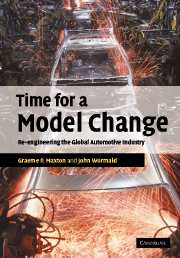Book contents
- Frontmatter
- Contents
- List of figures
- Foreword by G. Fredric Bolling
- Acknowledgements
- Glossary
- Introduction
- 1 From automania to maturity – in the main markets at least
- 2 The problems that can be fixed – dealing with noxious emissions, traffic accidents and congestion
- 3 The global resource challenges – energy and global warming
- 4 A global industry and the changing international order
- 5 The supplier industry – the catalyst for the profound changes to come?
- 6 The downstream sales and service sector
- 7 When the labels do not add up
- 8 Choosing a future for the automotive industry
- 9 Time for a model change
- Index
2 - The problems that can be fixed – dealing with noxious emissions, traffic accidents and congestion
Published online by Cambridge University Press: 22 September 2009
- Frontmatter
- Contents
- List of figures
- Foreword by G. Fredric Bolling
- Acknowledgements
- Glossary
- Introduction
- 1 From automania to maturity – in the main markets at least
- 2 The problems that can be fixed – dealing with noxious emissions, traffic accidents and congestion
- 3 The global resource challenges – energy and global warming
- 4 A global industry and the changing international order
- 5 The supplier industry – the catalyst for the profound changes to come?
- 6 The downstream sales and service sector
- 7 When the labels do not add up
- 8 Choosing a future for the automotive industry
- 9 Time for a model change
- Index
Summary
Diseases of underdevelopment (1) – noxious emissions
The car has always had its enemies. In the early years, Anti-Automobile Associations were common, particularly among farmers in America. Many pioneering drivers suffered verbal abuse, vandalism and ridicule, particularly if their cars broke down. Indeed, it was not uncommon for early drivers to give up their machines after a few years, such was the harassment.
Of course, cars have their drawbacks. They are polluting and noisy. Cars and their drivers have been responsible for millions of premature deaths and injuries in the last hundred years. Roads now penetrate some of our most beautiful landscapes, our cities have been reorganised into one-way systems and our gardens and basements changed into parking places. Our city centres are choked with vehicles every day and our lives are blighted by traffic jams. These are probably the most obvious drawbacks. Other negative effects of vehicles include damage to building foundations, emissions from paint shops, leakage from abandoned batteries and air-bag propellants, as well as the dumping of used motor oil. More than 500 million tyres are discarded annually worldwide, as are more than 600 million gallons of engine oil.
This section looks at the socio-economic costs of motoring and the role of governments. In the first part we look at emissions and then road deaths before covering congestion. Finally we look at the role of governments in addressing these problems.
The prospects for noxious emissions can appear exceedingly gloomy to the casual observer.
- Type
- Chapter
- Information
- Time for a Model ChangeRe-engineering the Global Automotive Industry, pp. 31 - 63Publisher: Cambridge University PressPrint publication year: 2004



